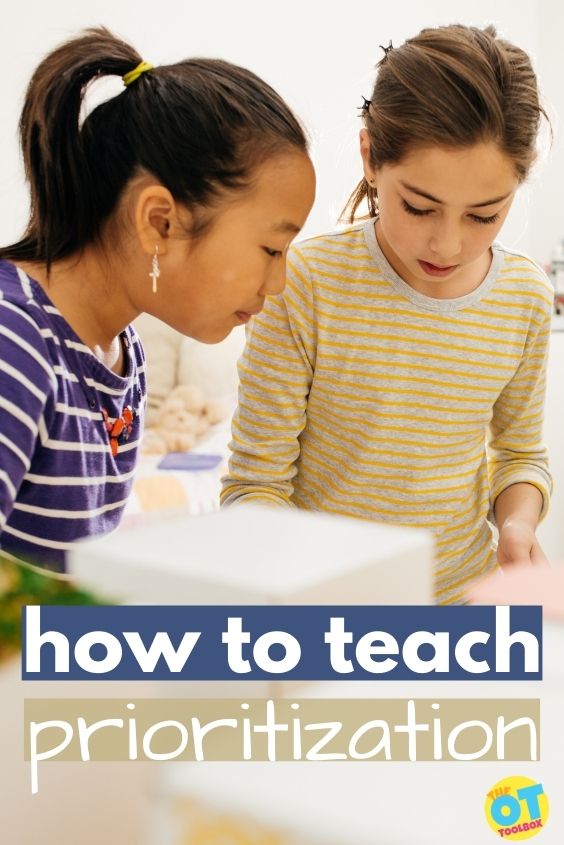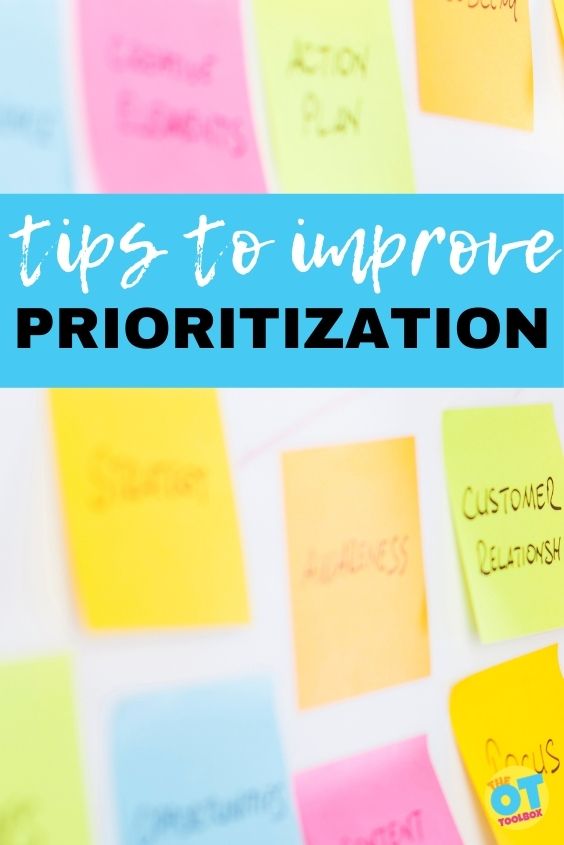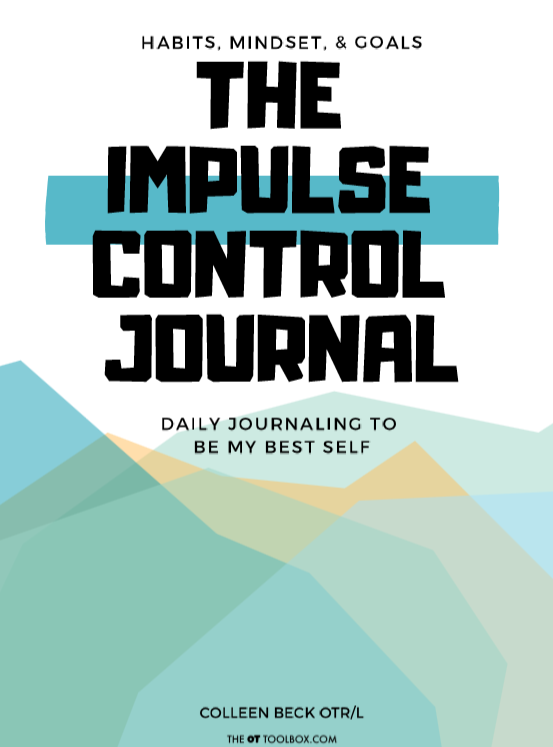Prioritization is a challenge for many. Here, we are talking all about tips for prioritizing tasks and time management. Did you ever has so much to do that you didn’t know where to begin? Prioritization is a huge part of accomplishing a task, but also getting started and task completion. These executive functioning skills can stall the most organized person. For our kids and teens, these skills can be a challenge that impacts learning and functioning. With a few tools and strategies, prioritization can become second-nature.

Previously, we have talked about planning and prioritization. You’ll find some tips and ideas on that blog post. But the process of thinking through a multi-step task and ordering the steps to completion can be the breakdown area for some kids. That ability to identify high priority tasks and rate them compared to low priority tasks can be quite difficult.
That ability to prioritize tasks can become so challenging in the face of a giant to-do list. How does prioritization impact functioning? How does executive functioning development impact the ability to prioritize tasks so that things can get done? Let’s explore prioritization skills and how to develop this essential skill.
What is prioritization
Prioritization is the process of figuring out what parts of a task or activity are the most important and what is the first thing that needs to be done and what is the most important part of the project that needs to be completed. Prioritization is an executive functioning skill that requires several other executive functions.
Prioritization is the ability to identify tasks in an order that makes sense.
When tasks are identified as high priority tasks or low priority tasks and then ranked, a job can be accomplished. For some, writing out these tasks is essential. For others, breaking those high and low priority tasks into mini-goals is also essential to Executive functioning skills development
Prioritization is a skill necessary for classroom activities, homework, multiple step projects, and tasks like cleaning a room or playing games. Kids who struggle with one piece of the many parts that make up prioritization will have difficulties figuring out what is the important parts of a task in order to even get started.
To pick out important parts, begin a project, and complete a part of a project, it’s important that the child has the following skills:
- Initiation
- Sustained attention
- Task completion
- Working memory
In addition to these executive function skills, a child needs attention and focus in order to propritixe part of an activity.
The key to prioritization is understanding and determining a specific task or part of the task that is most importat.

Tips for improving prioritization
It can be overwhelming for a child who struggles with any of the executive function skills that enable prioritization. Big jobs or even big activities like reading a chapter book can seem like a giant looming over them and getting started just doesn’t happen!
prioritizing tasks and time management
Prioritizing tasks impacts time management and vice versa. If a child struggles to identify which task is high priority in a project or functional task, they can struggle with task completion. For tasks that have a specific end date or deadline (such as homework or a bigger school project), this directly impacts the child’s ability to effectively manage their time. Then, the task isn’t completed.
To help a child with the ability to complete big tasks, help them break down the steps.
Start by listing out all of the parts of a task. Cleaning a room requires toys to be cleaned up from the floor before vacuuming can be done.
It can be helpful to sit down with your child and list out all of the parts of an activity to teach and model prioritization.
- Use a blank piece of paper and together, write down all of the individual pieces that make up a big job or project. Once they are all written down, don’t let that list overwhelm your child!
- Then, add numbers for each job task. Order them in order that they must be completed or in order of importance.
- Once a starting point is identified, it can be easy to set small goals to complete that part of the job.
- Set up a time slot for the individual tasks to be completed. It can be helpful to use a timer to help with initiation.
Prioritization Strategies
There are different strategies for addressing prioritization of a multi-step task, involving breaking out the individual tasks into steps.
Try these strategies to help children prioritize tasks:
- Doing the easiest task job first might be helpful for the child who feels a sense of accomplishment and then gets a self-esteem boost.
- Other kids might do the smaller jobs first so that a bigger portion of the overall job is completed.
- Another strategy is to do the more complex parts first when the child has more attention and focus on the project.
- Use a graphic organizer. Put the big job in the middle and write out completed parts in smaller circles that shoot off from the center. Kids can color in each circle as they compete the individual smaller jobs.
- Make lists
- Use a calendar with color-coded sections for more complex jobs or ongoing tasks such as parts of a large homework project.
- Use a graphic organizer to draw out tasks and sub tasks.
- Use sticky notes to write out the small jobs of a larger task. Kids can pull off the sticky notes as they complete each job.
More ways to help with prioritization
Want to really take executive function skills like planning and prioritization to the next level of success? The Impulse Control Journal is your guide to addressing the underlying skills that play into trouble with planning and prioritization.
The journal is an 80 page collection of worksheets and prompts to discover what’s really going on behind executive functioning skills like planning, organization, prioritization, working memory, and of course, impulse control.
The Impulse Control Journal…a printable resource for helping kids strategize executive functioning skill development. When saying “calm down” just isn’t enough…
When a child is easily “triggered” and seems to melt down at any sign of loud noises or excitement…
When you need help or a starting point to teach kids self-regulation strategies…
When you are struggling to motivate or redirect a child without causing a meltdown…
When you’re struggling to help kids explore their emotions, develop self-regulation and coping skills, manage and reflect on their emotions, identify their emotions, and more as they grow…
Grab the Impulse Control Journal to build organizational strategies, planning, prioritization, habits, and mindset in kids.
This is a HUGE digital resource that you can access and print to use over and over again.

Colleen Beck, OTR/L has been an occupational therapist since 2000, working in school-based, hand therapy, outpatient peds, EI, and SNF. Colleen created The OT Toolbox to inspire therapists, teachers, and parents with easy and fun tools to help children thrive. Read her story about going from an OT making $3/hour (after paying for kids’ childcare) to a full-time OT resource creator for millions of readers. Want to collaborate? Send an email to contact@theottoolbox.com.







